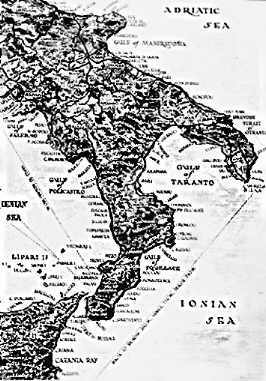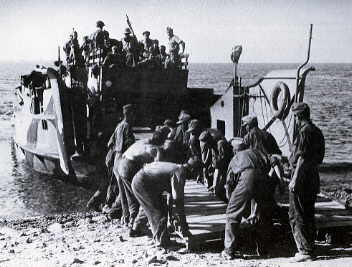
These pages give a condensed overview of the Italian Campaign from the invasion of Sicily to the end of the war in Europe.

The allied victory in North Africa was only the beginning. After Rommels evacuation of his Afrika Corps, the next logical allied target was Sicily. A plan was hatched to fool the Germans into thinking that the next allied move would be to invade Sardinia & Corsica, so as to divert German attention from what would be (& still remains today) the biggest amphibious landing in history, 'Operation Husky'.
Allied views differed as to the importance of 'Husky', the Americans favored a massive invasion across the channel and a thundering charge through France into Germany itself, whereas the British (with memories of the Slaughter of the first world war fresh in their minds) favored a more indirect, pragmatic approach. Nibble away at the Reich with blockading and bombing until the opportunity arose for a deadly strike. The Americans feared that an invasion of Italy would drain men and equipment from the 'main show' a cross channel invasion. General Marshall was prepared to say that if Britain kept insisting on an Italian Campaign, the Americans would put all their effort into the Pacific war and just let the European conflict to drift. Fortunately a compromise was reached, until forces could be built up to invade France the pressure would be kept on by an invasion of Sicily but not necessarily to invade the mainland.
So 'Husky' went ahead, despite some serious defensive action by the Germans (most Italian units were glad to surrender at the first opportunity) 'Husky' was a success. In the 38 days it took to drive the last Axis forces across the Strait of Messina onto mainland Italy, the US 7th army suffered 7,500 casualties, the British 8th army 11,500. The Germans lost 12,000 killed or captured, the Italians 145,000. 40,000 German & 70,000 Italians managed to get back to Italy along with 9,600 vehicles, 47 tanks and about 200 artillery pieces.

The last Germans to leave Sicily load their landing craft in broad daylight, giving lie to the allied air forces claims that they sunk 24 Axis boats and damaged 43 more. The actual losses were six German, one Italian boat sunk and seven or eight more damaged!
On the 3rd of September, Montgomery's 8th Army crossed the straights of Messina to the Italian mainland and on 9th of September, the Allies landed at Salerno. Ever since their defeats in North Africa, many Italians wanted to get out of the war. When it was obvious that Sicily would fall to the Allies, Victor Emmanuel, III, King of Italy, dismissed Mussolini who was then placed under house arrest. Many Italians feared severe German retaliation if Italy surrendered to the Allies. In secret negotiations with the Allies, the Italians tried to extract from the Allies that British and American troops would invade the mainland of Italy in sufficient force to protect them from their former allies, the Germans. They even wanted the United States to drop an airborne division on Rome to help Italian troops guard the city against the Germans. On the eve of the invasion of the Italian mainland, Eisenhower even went so far as to send General Maxwell A. Taylor on a clandestine mission to determine the feasibility of a plan to drop the 82nd airborne division into Rome. Taylor moved past German positions by PT boat, landed at Gaeta, and slipped into Rome on September 8, 1943, but he reported that Italian troops would not be able to secure the airfields and recommended against the drop. Moreover, the Allies having fought the Italians for several years, were wary of Italian solicitude.
The Italians were obliged to sign a take-it-or-leave-it surrender with the Allies which would be announced on September 8. The Allies intended to land at Salerno early on September 9 and they hoped to cause great confusion among the Germans. Having already anticipated that Italy might drop out of the war, the Germans were neither surprised or confused. In fact, they already had plans to sacrifice much of the Italian peninsula and retire to a line running from Pisa to Rimini where they could defend the approaches to the German homeland. After the Italian surrender the Allies pushed quickly inland around the vital Monte corvino airfield and fighting raged inconclusively all day. The Luftwaffe was making a major effort against Allied shipping in Gulf of Salerno. This included launching a new weapon, a remote control glide bomb which managed to sink four transports, one heavy cruiser, and seven landing craft, also inflicting varying degrees of damage on other ships. The Germans were unable to hold back the Allied force on their own and after nine days of heavy fighting, they had pulled back from the beachhead as part of their established plan to fall back to positions in the Northern Apennines. There was no head long retreat to Rome in the north, but instead a calculated withdrawal that established a succession of defensive lines across the peninsula. The nine-day period cost the Americans 3,500 casualties and the British 5,500 casualties. With the successful conclusion of the first large scale opposed landing on the European continent, the Allies now had control of the Mediterranean and were in Italy to stay.
After heavy fighting, the U.S. Rangers had driven the Germans from the high ground and mountain passes around Salerno, this enabled the allies to begin the drive on Naples. The main drive on Naples was conducted by the British 46th Infantry and 7th Armoured divisions while the American 3rd and 45th Infantry divisions were to swing through the mountains and threaten Naples from the east. The British 56th division would bypass Naples and head through the mountains directly to the Volturno River. The Germans were in the process of totally wrecking the port of Naples and were determined to make the allies pay in blood and sweat for every mile of their advance.
As the Americans started through the mountains, they found they were restricted to a few roads that wound and twisted through narrow gorges and passes. The Germans blew up over 25 bridges along the way, these had to be replaced, under enemy fire, by pre-fabricated bridges or by simply bulldozing rubble in to the space where the bridge used to be. These bulldozers were prime targets for the Germans and many engineer drivers were killed until somebody came up with the idea of fitting ploughs to some Sherman tanks. These 'Tankdozers' allowed construction to continue even under fire and they helped the advance to continue. Because of the terrain most units had to rely on Mules to carry equipment, each division needed 300-500 mules, also, the food, shoes, nails, packs, etc, for them. This in turn led to frantic searches for veterinarians, harness makers, blacksmiths and mule skinners to manage the beasts!
All the troops had hard going and the British didn't enter the city of Naples until the first of October, units of the American 82nd Airborne division also entered the city that same day. The British pressed on for another 20 miles against stiff opposition until they were halted at the Volturno six days later. The Germans had had two weeks to wreck Naples and they'd done a pretty good job of it, booby traps were everywhere, the sewer and water supplies had been blown up at more than 50 points, streets were obstructed by rubble barricades in more than 200 places and because of allied bombing and the German demolition teams, the port was blocked by more than 130 scuttled vessels of every shape and size. The engineers immediately went to work, repairing the sewer and water mains, clearing the streets and even restored some power using an old trollybus station and the generators from three captured Italian submarines in the harbor! The salvage teams working in the harbor did fantastic work, and within only four days the first Liberty ship had docked and was being unloaded, within a month over 7,000 tons of material was being unloaded per day.
As a side note, the celebrating allied soldiers now met another potent enemy, gonorrhea. It put a soldier out of action as surely as a wound and became so prevalent that the brothels in Naples had to be put off limits.